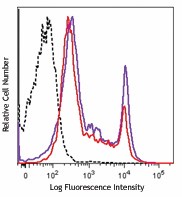- Regulatory Status
- RUO
- Other Names
- Fixable Dye, Fixable Viability Dye

-

One day old C57BL/6 mouse splenocytes were stained with Zombie Yellow™ and analyzed before fixation (purple) or after fixation and permeabilization (red). Cells alone, without Zombie Yellow™ staining, are indicated in black.
| Cat # | Size | Price | Quantity Check Availability | ||
|---|---|---|---|---|---|
| 423103 | 100 tests | $89.00 | |||
| 423104 | 500 tests | $335.00 | |||
Zombie Yellow™ is an amine-reactive fluorescent dye that is non-permeant to live cells but permeant to the cells with compromised membranes. Thus, it can be used to assess live vs. dead status of mammalian cells. Zombie Yellow™ is a polar, water soluble dye providing bright yellow fluorescence, making it suitable for multi-color detection.
Product Details
- Preparation
- Zombie Yellow™ Fixable Viability Kit is composed of lyophilized Zombie Yellow™ dye and anhydrous DMSO. For reconstitution, bring the kit to room temperature; add 100 µl of DMSO to one vial of Zombie Yellow™ dye until fully dissolved. 100 tests = 1 vial of Zombie Yellow™ + DMSO, 500 tests = 5 vials of Zombie Yellow™ + DMSO.
- Storage & Handling
- Store kit at -20°C upon receipt. Do not open vials until needed. Once the DMSO is added to the Zombie Yellow™ dye, use immediately, or store at -20°C in a dry place and protected from light, preferably in a desiccator or in a container with desiccant for no more than one month.
- Application
-
FC - Quality tested
- Recommended Usage
-
Each lot of this product is quality control tested by immunofluorescent staining with flow cytometric analysis.
For flow cytometry, the suggested dilution is 1:100-1:1000 for 1-10 million cells. It is recommended that the reagent be titrated for optimal performance for each application, as optimal dosage varies with cell type. - Excitation Laser
-
Violet Laser (405 nm)
- Application Notes
-
Zombie Yellow™ dye is excited by the violet laser and has a fluorescence emission maximum of 572 nm. If using in a multi-color panel design, filter optimization may be required depending on other fluorophores used. Zombie Yellow™ dye has similar emission to Brilliant Violet 570™.
Standard Cell Staining Protocol:- Prior to reconstitution, spin down the vial of lyophilized reagent in a microcentrofuge to ensure the reagent is at the bottom of the vial.
- For reconstitution, pre-warm the kit to room temperature; add 100 µl of DMSO to one vial of Zombie Yellow™ dye and mix until fully dissolved
- Wash cells with PBS buffer (no Tris buffer and protein free).
- Dilute Zombie Yellow™ dye at 1:100-1000 in PBS. Resuspend 1-10 x 106 cells in diluted 100 µl Zombie Yellow™ solution. To minimize background staining of live cells, titrate the amount of dye and/or number of cells per 100 µl for optimal performance. Different cell types can have a wide degree of variability in staining based on cell size and degree of cell death.
Note: Don’t use Tris buffer as a diluent and be sure that the PBS does not contain any other protein like BSA or FBS.
Note: The amount of dye used can also influence the ability to detect apoptotic as well as live and dead cells. - Incubate the cells at room temperature, in the dark, for 15-30 minutes.
- Wash one time with 2 ml BioLegend’s Cell Staining Buffer (Cat. No. 420201) or equivalent buffer containing serum or BSA.
- Continue performing antibody staining procedure as desired.
- Cells can be fixed with paraformaldehyde or methanol prior to permeabilization or can be analyzed without fixation.
No-wash Sequential Staining Protocol:
- Wash cells with PBS buffer (no Tris buffer and protein free).
- For reconstitution, pre-warm the kit to room temperature; add 100 µl of DMSO to one vial of Zombie Yellow™ dye and mix until fully dissolved
- Determine the total µl volume of antibody cocktail previously titrated and optimized for the assay that will be added to each vial/well of cells based on a final volume of 100 µl. Subtract that antibody volume from the 100 µl total staining volume intended for the assay. In the remaining volume, dilute Zombie Yellow™ dye at 1:100-1000 in PBS as determined by prior optimization at that volume. For example, if you are adding 20 µl of antibody cocktail for a 100 µl total staining volume, use 80 µl of Zombie Yellow™ solution. Resuspend 1-10 x 106 cells in the appropriate volume of Zombie Yellow™ solution. Different cell types can have a wide degree of variability in staining based on cell size and degree of cell death.
Note: Don’t use Tris buffer as a diluent and be sure that the PBS does not contain any other protein like BSA or FBS.
Note: The amount of dye used can also influence the ability to detect apoptotic as well as live and dead cells. - Incubate for 10-15 minutes at RT, protected from light. Without washing the cells, add the cell surface antibody cocktail and incubate for another 15-20 minutes.
- Add 1-2 mL Cell Staining Buffer (Cat. No. 420201) or equivalent buffer containing BSA or serum. Centrifuge to pellet.
- Continue with normal fixation and permeabilization procedure. If planning to skip fixation and analyze cells live, complete an additional wash step to minimize any unnecessary background of the live cells.
Notes: If the cell type in use cannot tolerate a protein-free environment, then titrate the Zombie Yellow™ dye in the presence of the same amount of BSA/serum as will be present in the antibody staining procedure. A higher amount of Zombie Yellow™ may be required since the BSA/serum will react with and bind up some proportion of the Zombie Yellow™. -
Application References
(PubMed link indicates BioLegend citation) - Product Citations
-
Antigen Details
- Biology Area
- Apoptosis/Tumor Suppressors/Cell Death, Cell Biology, Neuroscience
- Gene ID
- NA
